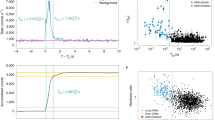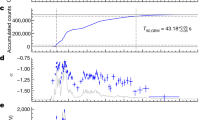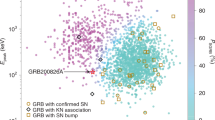Abstract
The basic nature of cosmic γ-ray burst sources1 has remained a mystery. Schaefer2 and Schaefer et al.3 recently discovered three images on archival photographic plates probably due to optical flashes from the error boxes of three γ-ray burst sources. This discovery opens up the possibility of ground-based optical studies of these objects (see, for example, ref. 4) and provides an important new set of data that can constrain models significantly (see, for example, ref. 5 and references therein) for these intriguing sources. London and Cominsky6 have considered a model for the optical flashes, wherein γ-ray bursts are emitted by a collapsed object in a close-binary stellar system and a small fraction of the γ radiation is reprocessed into optical radiation in the surface layers of the companion star (see refs 7 and 8 for possible alternative explanations). Based on their own estimates of the time, τ, required to reprocess the γ radiation into optical light, London and Cominsky concluded that a binary model would not account for the observed optical flashes. They considered, however, only main-sequence stars and hydrogen-depleted degenerate dwarfs as possible companion stars. We reconsider here the binary model and conclude that it is viable. In particular, under the assumption that the optical flashes were produced by γ-ray bursts of about the same intensity as those observed, we find that nearby (≲100 pc) binary systems with secondaries whose masses are less than ∼0.06 M⊙ can fit all the observational constraints for the three optical/γ-ray pair events (hereafter 1928/1978, 1944/1979 and 1901/1979; see Table 1).
This is a preview of subscription content, access via your institution
Access options
Subscribe to this journal
Receive 51 print issues and online access
$199.00 per year
only $3.90 per issue
Buy this article
- Purchase on Springer Link
- Instant access to full article PDF
Prices may be subject to local taxes which are calculated during checkout
Similar content being viewed by others
References
Klebesadel, R. W., Strong, I. B. & Olson, R. A. Astrophys. J. Lett. 182, L85–L88 (1973).
Schaefer, B. E. Nature 294, 722–724 (1981).
Schaefer, B. E. et al. Astrophys. J. Lett. 286, L1–L4 (1984).
Ricker, G. R., Doty, J. P., Vallerga, J. V. & Vanderspek, R. K. Soc. Photo-Opt. Instrum. Engr. 445, 370 (1984).
High-Energy Transients in Astrophysics (ed. Woosley, S. E.) (American Institute of Physics, New York, 1984).
London, R. A. & Cominsky, L. R. Astrophys. J. Lett. 275, L59–L63 (1983).
Woosley, S. E. in High-Energy Transients in Astrophysics (ed. Woosley, S. E.) 485 (American Institute of Physics, New York, 1984).
Katz, J. Astrophys. Lett. (in the press).
Rappaport, S., Verbunt, F. & Joss, P. C. Astrophys. J. 275, 713–731 (1983).
Mazets, E. P. et al. Astrophys. Space Sci. 80, 3–83 (1981).
Mazets, E. P. et al. Astrophys. Space Sci. 80, 119–143 (1981).
Schaefer, B. E. & Ricker, G. R. Nature 302, 43–45 (1983).
Schaefer, B. E., Seitzer, P. & Bradt, H. V. D. Astrophys. J. Lett. 270, L49–L52 (1983).
Pedersen, H. et al. Astrophys. J. Lett. 270, L43–L47 (1983).
Barat, C. et al. Astrophys. J. Lett. 286, L5–L9 (1984).
Schaefer, B. E. thesis, Massachusetts Inst. Technology (1983).
Oort, J. H. Bull. Astr. Inst. Neth. 15, 45 (1960).
Bahcall, J., Hut, P. & Tremaine, S. Astrophys. J. (in the press).
Ventura, J., Bonazzola, S., Hameury, J. M. & Heyvaerts, J. Nature, 301, 491–493 (1983).
Elvis, M., Soltan, A. & Keel, W. C. Astrophys. J. 283, 479–485 (1984).
Grindlay, J. E. et al. Nature 300, 730–731 (1982).
Joss, P. C. & Rappaport, S. in High-Energy Transients in Astrophysics (ed. Woosley, S. E.) 555 (American Institute of Physics, New York, 1984).
Author information
Authors and Affiliations
Rights and permissions
About this article
Cite this article
Rappaport, S., Joss, P. On the binary nature of cosmic γ-ray burst sources. Nature 314, 242–245 (1985). https://doi.org/10.1038/314242a0
Received:
Accepted:
Issue Date:
DOI: https://doi.org/10.1038/314242a0
This article is cited by
-
Search for GRB counterparts in the optical
Astrophysics and Space Science (1995)
Comments
By submitting a comment you agree to abide by our Terms and Community Guidelines. If you find something abusive or that does not comply with our terms or guidelines please flag it as inappropriate.



